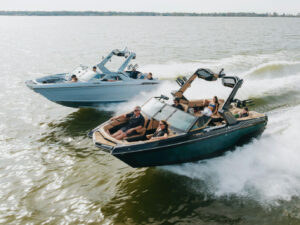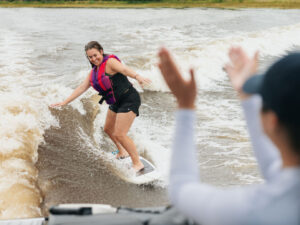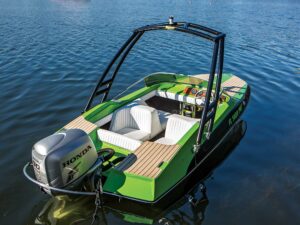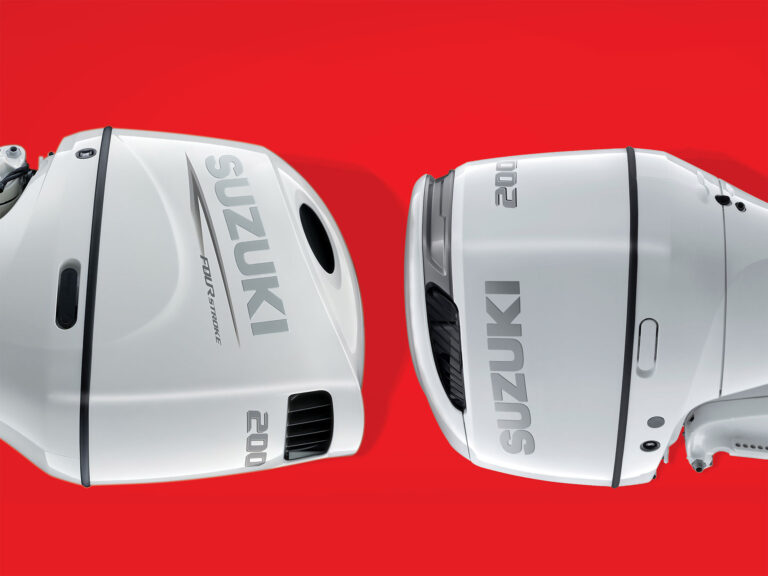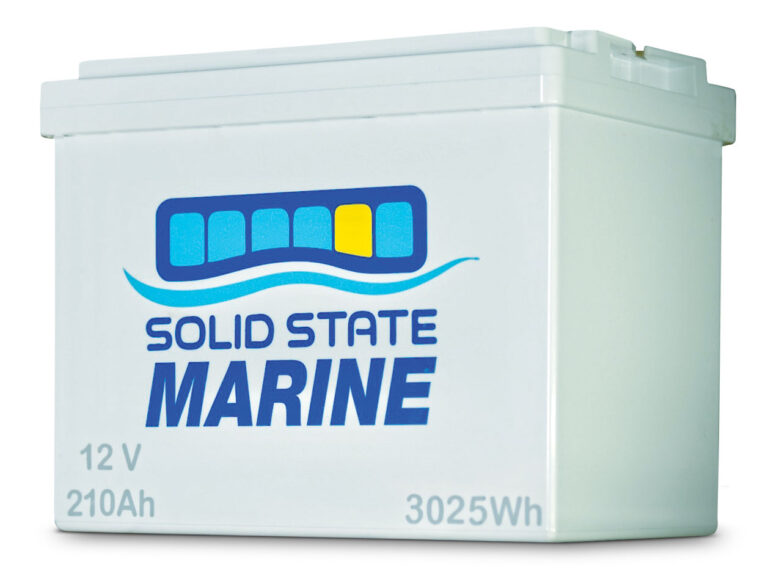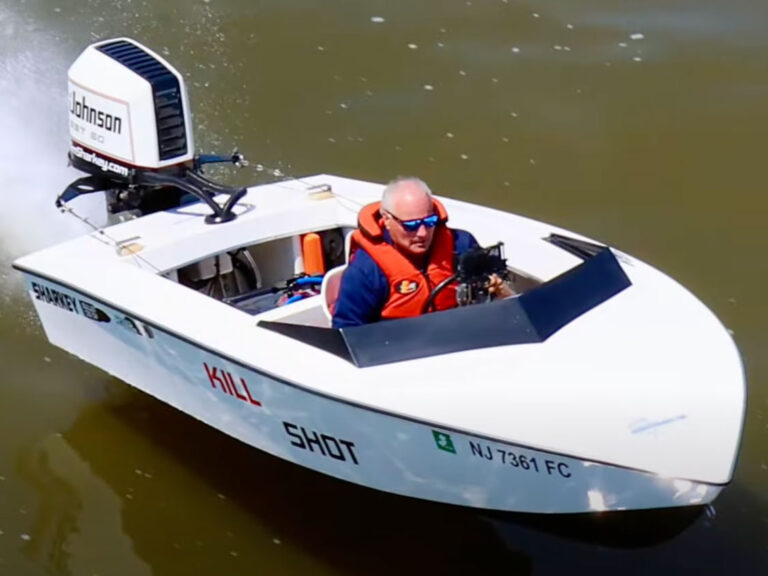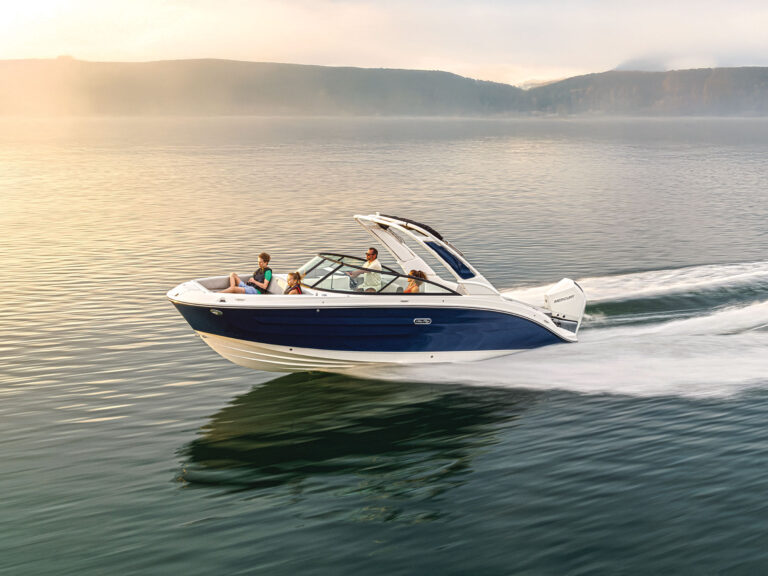When it comes to buying a new ski boat, you have to do a lot more than kick the tires. You have to be in the know. An informed buyer is a smart buyer. Here at Boating, we want to help you become that informed buyer, which is why we put together this tutorial of details you should pay attention to while shopping for your new ski boat or wakeboard boat. The areas we focus on are size, test drives, trailering, insurance, financing and a final checklist to complete the search for your ultimate water machine. Keep this boat buyers guide in mind as you navigate through our ski boat reviews, then use it as a reference guide when you’re hitting the dealerships. Trust us, we’re in this with you.
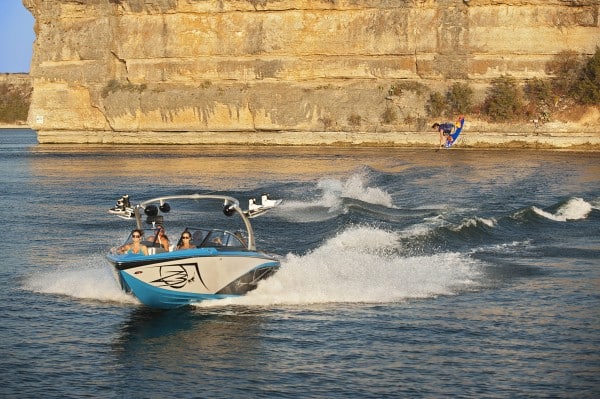
SIZE MATTERS
At the beach during spring break, all the $5 T-shirts claim “one size fits all.” Well, this isn’t the beach, and it sure isn’t chump change you’re laying down for a new ski boat, so understanding how to pick the right size for you is the surest way to get the best bang for your buck.
This means you need to pay attention to the beam, which is the measured width of the boat at its widest point. Wider ski boats and wakeboarding boats can mean more interior space available, which means more friends can hop aboard. The interior space is also influenced by the hull and deck styling, so a larger beam does not necessarily mean more room. The affect on performance is much more difficult to measure as the beam changes.
The prime length for boats designed primarily for water skiing is about 20 feet or so, and a wider boat will often ride higher, thus displacing less water and providing a smaller wake. On the other side of the aisle, though, the ideal size for a wakeboarding boat tends to be in the 21- to 24-foot range, with at least a 100- to 102-inch beam.
The larger the boat’s surface area, the more weight required to displace water. Because of this, larger boats sometimes sacrifice performance and don’t always make a bigger or better wake.
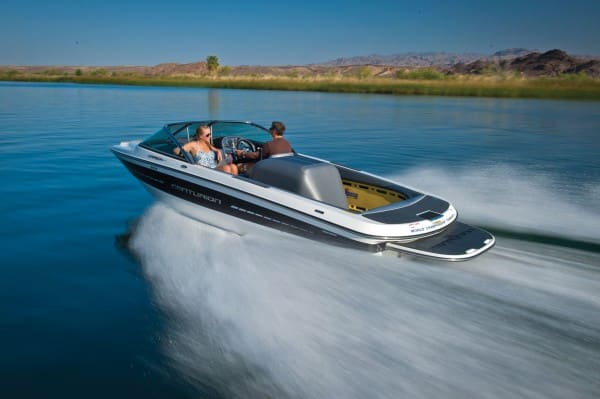
TEST YOUR RIDE — GET IT WET
You wouldn’t buy a car off the lot without first taking it for a spin, and you wouldn’t buy new shoes before walking around in them. So when it comes to your new ski boat, don’t settle for just stalking around the sales floor and admiring the pretty colors. Get it wet. Insist on test-driving the boat in the closest body of water available to you.
Once you’re on the water, there are a number of things to consider. Make sure the boat accelerates well with minimal bow rise, both weighted and unweighted. Does it turn as it should and not “roll up” in a turn? Maneuver the boat at both high speeds and slow speeds, and check visibility. How does it ride in rough water? Does it rattle, flex or creek? The steering should react quickly at any speed and the steering wheel needs to be easy to turn with one finger.
After you test the boat’s handling capacity, it would be advantageous to give the wakes a test ride as well. Is the slalom wake soft and flat at the line lengths you commonly ski at? Is the wakeboard wake steep or does it have a gradual transition? How well does it cater to your riding style?
If you’re looking for a crossover boat, it’s a good idea to make sure the wake can be altered to benefit your sport of choice. Do the ballast and the wake-enhancement plates change the wake to your liking? See if there is true adjustability and wake customization, because if you have both skiers and wakeboarders in your family, you want to keep everyone happy.
Joe and Matt Mueller of Minnesota Inboard, one of Malibu’s top dealers, have a “value checklist” that tells their customers what to look for.
Quality How sturdy is the build? Is the engine a respected name? How solid is the manufacturing? What’s the reputation of the brand?
Features Amazingly, for some people, the more cup holders a boat has, the better it is. This may not be your criteria, but take the time to evaluate the features that are important to you.
Performance While you’re driving, pay attention to acceleration, bow rise, tracking, turnability, responsiveness, rough-water ride and wake performance.
Price For most of us, price is the determining factor in any purchase. But once you’ve settled on your range, take a look at what boats are in that range and what each has to offer. Then drive them all — with a big-ticket purchase like this, there’s no sense in rushing your decision.
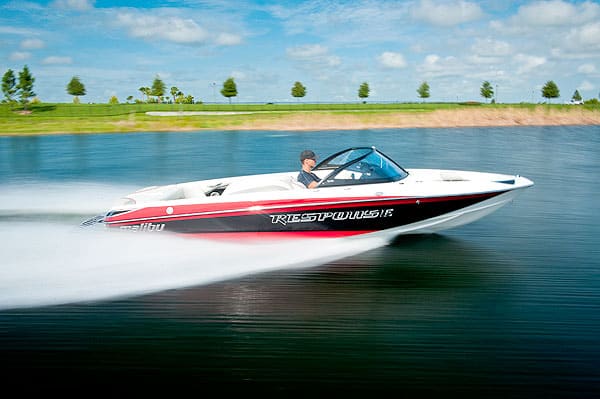
TO THE LAKE AND BACK AGAIN — TRAILERING YOUR BOAT
Once you’ve purchased your new ski boat, getting from the dealership to your garage, then from your garage to the lake, becomes a pretty big deal. Some of you are fortunate enough to live on the water, and getting around isn’t much of a concern. But for everyone else, let’s talk trailers.
Over the past 10 years our industry has evolved from the single-axle trailer to the tandem-axle. As ski boats and wakeboarding boats continue to get longer, wider and heavier, the need for tandem-axle trailers has become greater. They offer a smoother pull for your tow vehicle and also provide a safety blanket for those of us who are worried about getting a flat on a long road trip.
Most 19- to 21-foot boats will fit on a single-axle trailer, which costs less and is far easier to move around when not attached to a vehicle. But if you have a larger boat or you’ll be trailering over significant distances, you’ll want a tandem-axle trailer for the higher capacity and improved reliability. Have that spare tire and carrying bracket ready just in case. A custom-fit trailer can also avoid damage to the hull surfaces.
When it comes to the tow vehicle, be sure to consider the total weight of the boat with fluids, trailer and gear. An eight-cylinder vehicle is recommended for any combined boat-and-trailer weight over 4,500 pounds. Smaller engines and trucks will pull them, but depending on altitude, temperature and incline, they can really struggle.
Torque and gearing are more important than horsepower. Also, it’s best to find a vehicle with a manufacturer-installed towing package that provides additional cooling capacity for the transmission.
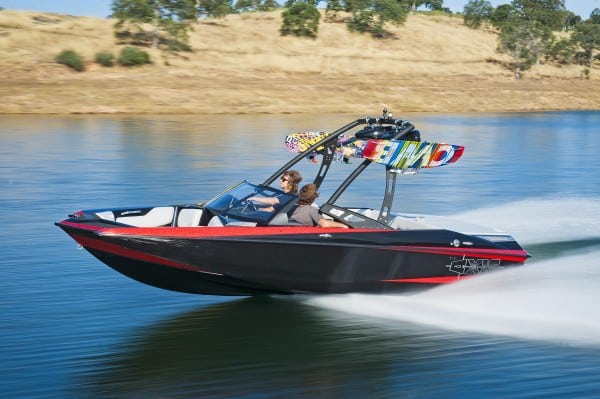
Axis A20
PEACE OF MIND — THE RIGHT BOAT INSURANCE
Don’t press your luck — underwater roots can poke a hole in the hull just as easily as Hurricane Bertha can break your hull in two. Leaving your investment to chance is a recipe for disaster. You definitely need insurance for your boat. Here are some pointers from Jim Stanley of Global Marine Insurance.
What will I pay? On average, an annual policy will run anywhere from $350 to $650, based on the owner’s experience, the value of the boat and the navigation area where the boat is used. Also, living in hurricane-prone areas can raise your premiums.
How much do I need? Your boat should be insured for its purchase price with an agreed value policy. Also, make sure you have sufficient liability limits. Check with your lake, club or specific organizations to see what liability limits they require. You may consider coordinating your liability coverage with an umbrella policy, if you have one.
Can I package my boat insurance with my house, car, etc. to get a better deal? Sometimes, but keep in mind you might not always get the benefits of a true boat policy. This is especially critical for anyone who is considering using his boat for any type of sanctioned activity — most “package policies” exclude these types of events.
How do I find the best insurance company/agent for me? Of course, the Web is always a good place to start. But the Web can be a no man’s land when it comes to finding an agent you can trust. It’s probably best to ask organizations, manufacturers and dealers — or better yet, see who your ski/wakeboard buddies use. Odds are they have a marine-specific agent they can recommend.
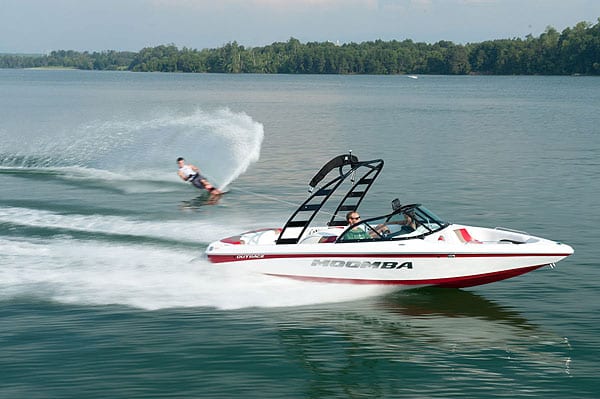
THE MONEY SHOT: DOWN PAYMENTS AND FINANCING
The money issue, when it comes down to it, is the most important part about buying your new boat. No coin, no boat. With the economy in the stinker, maybe we can get Mr. President to send some stimulus our way, right? Don’t hold your breath.
You’ll find different rate and down payment expectations at various dealers, but expect between a 10 to 20 percent down payment.
Matt Mueller says most banks require 10 percent down and offer a fixed rate for 12 to 15 years. With most boats ranging between $50,000 and $80,000, monthly payments are generally between $500 and $700, depending on the term. Of course, monthly payments can slide up and down that range if the interest rate (APR) changes, so make sure to keep an eye on the numbers. If your interest rate changes, call and ask why. Sometimes you can keep it at your lowest rate just by asking.
Interest rates and the length of the loan will vary based on candidate, security, location and product, so contact your local dealer for exact monthly payments, rates and terms.
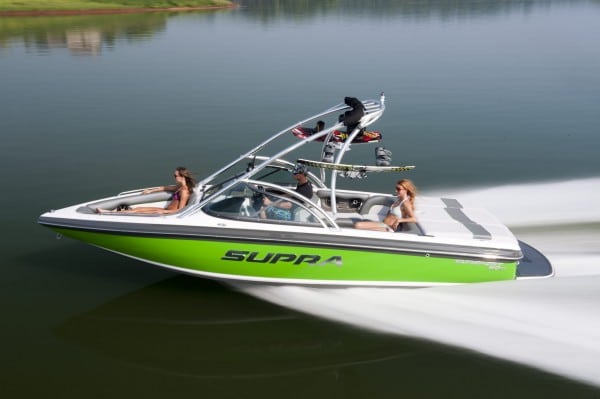
YOUR FINAL CHECKLIST — FEATURES, STORAGE, COMFORT, ETC.
OK, this is your final checklist. When you’re shopping for your new ski boat, use this to make sure all the “small stuff” is in order, because small things can become big problems really quickly.
Features. It’s your boat — make sure it has the features you want, such as a hard tank and subfloor ballast with a monitoring system. Check out the rider presets, cup holders and interior lights, and decide if dual gas fills are important to you. Sit behind the dash and make sure it’s easy to see and operate. If the boat has a video screen, test it out. If you’re eyeing a multisport boat, try the wake enhancement device.
Storage. Many boats have lots of storage compartments, but sometimes they’re small and chopped up. Bring your gear with you to make sure you can actually store it, paying attention to how easy it is to access the compartments. Also, be mindful that sacks may take up some storage space once your ballast is full.
Usability. Sometimes what looks good or cool in a showroom might not be usable on the water. Reach around and see if the cup holders are in the right places and easy to access. Then check the interior lights to make sure they really light up the interior. You’ll want the table to store neatly out of the way and set up easily. The same goes for the windbreak. Sit in the driver’s seat; swivel and turn all the way around. And lounge a bit in the rest of the seats to make sure they’re laid out comfortably.
Fit and Finish. Look the boat over for not only what you can see but also what you can’t. Look in the corners, under the dash, in the bilge and under the storage hatches. Make sure the edges are trimmed and clean. The wires should be out of sight and there should be no exposed glass or splinters. Check how the cushions and other trim pieces line up. Pinch the vinyl. It should return to its original position.
Comfort. Since the inside of the boat is where you’ll spend the majority of the day, make sure you’re comfortable — especially at the driver’s seat. It should have a usable, comfortable bolster and heat or a lumbar support. Sit and take notice of how the cockpit is laid out. Is the armrest in the right place? How are the ergonomics all around the boat? Check your seat backs and bottoms — you want them to be comfortable, thick and plush. The backs should be high enough to give support.
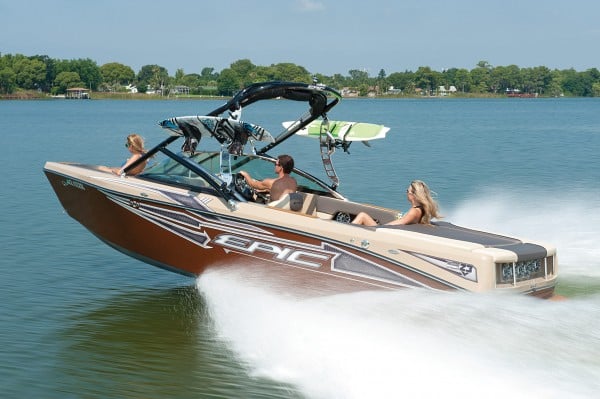
Epic 23V
THANKS
There you have it — everything you need to properly “kick the tires” with some know-how. Now that you know how to properly go about buying a ski boat, it’s time to start your search using Boating’s boat tests. Read our editor’s expert opinions on each model and check out all of the amazing innovations.

